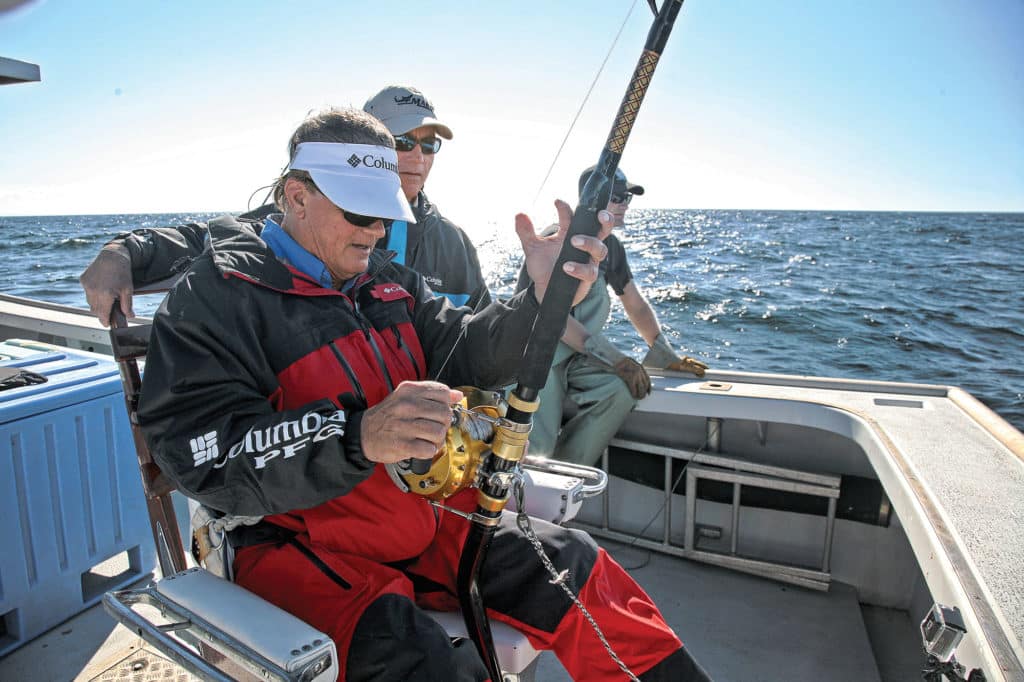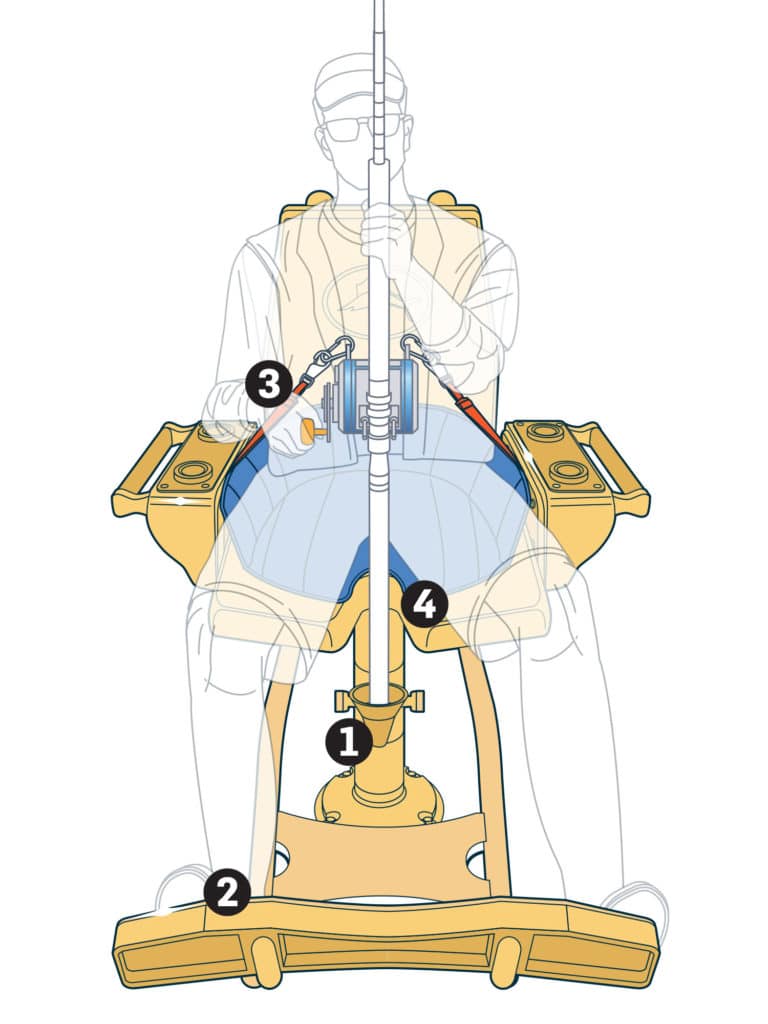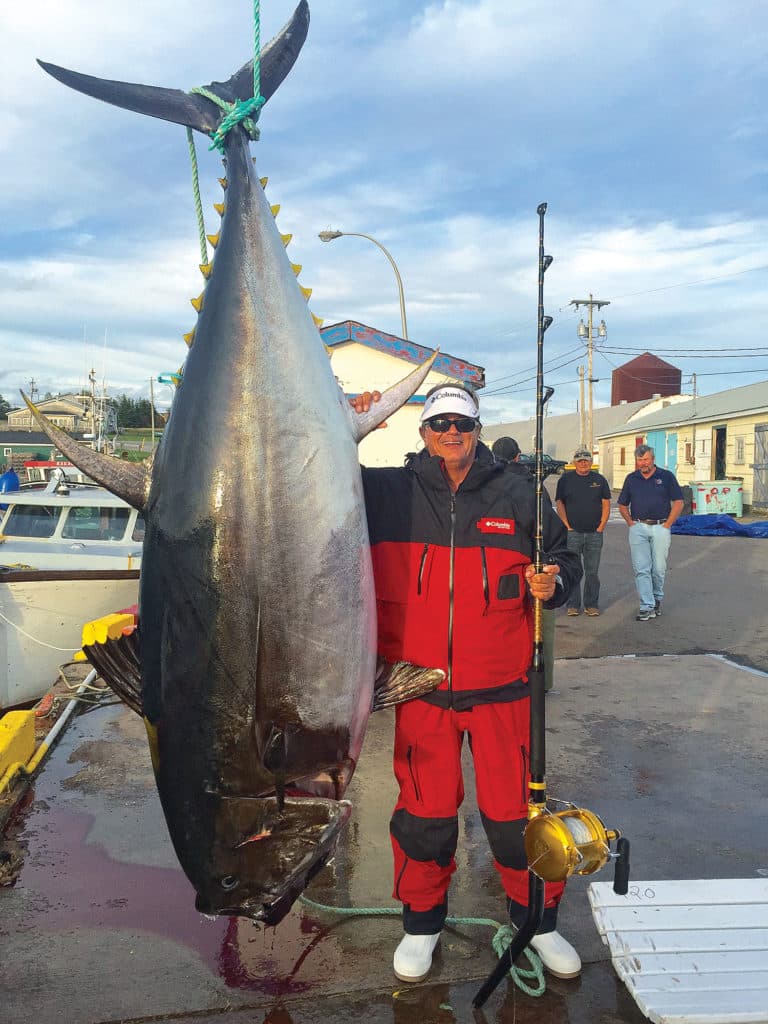
Taking to the fighting chair with 80- and 130-pound tackle isn’t for the faint of heart. Experience, or lack thereof, greatly influences whether a fish is whipped quickly and efficiently, or the angler suffers through a long and agonizing struggle instead. Success in the chair starts well before you hop into it.
Although most of my big-game experience is with stand-up gear, I’m no rookie when it comes to using a fighting chair. Yet before we left the dock during a trip to Prince Edward Island, Canada, for giant bluefin tuna, I spent 15 minutes reviewing fighting strategies with Capt. Mark Jenkins and adjusting the chair for the 130-pound-class tackle I’d be using. The payoff was several victories and a 701-pounder boated.
Prefight
The chair footrest was adjusted so my feet were firmly planted and my legs straight out. In this position, the forward edge of the chair lined up with the bend behind my knees, establishing the maximum pumping position — the farthest back I could extend in the chair.
With me sitting shy of the maximum pumping position, we clipped the bucket harness straps onto the reel, which was even with my knees. We then carefully adjusted each strap to support the reel and share the pressure evenly. If one strap were shorter, it would unfairly tax one portion of my body and make for an uncomfortable and cumbersome fight. By precisely adjusting the footrest and bucket harness, I would be able to apply pressure evenly with my legs and lower body while pumping, and I could alleviate that pressure when I slid forward on the seat to gain line.
The rod angle representing the highest amount of drag pressure (at full pumping position), incidentally, was 30 degrees for our curved-butt rods. If that leverage point were exceeded, the power curve would decline.
The Spotter
Being harnessed to heavy tackle and chair-bound is inherently dangerous business. Should something go wrong (a footrest breaking or the chair base pulling up), you could find yourself in a precarious situation. Therefore, as in bench-pressing in a gym, make sure you have a capable spotter standing by. It’s the spotter’s duty to turn the chair and keep you aimed at the fish, squirt liquid dish soap on the chair to facilitate sliding back and forth, remove the backrest should you wish to extend your pumps, and, most important, spot you in case of an emergency. Friend Carl Grassi assumed spotter duties on my Prince Edward Island trip, and I returned the favor when he was in the chair.

2) Set footrest with your legs straight and back of knees at the front of the chair seat.
3) Set length of both bucket harness straps so they support the reel evenly.
4) Apply a little liquid soap between seat and bucket harness for easier sliding. Tim Barker
Slide Job
Early on, if a fish such as a big marlin — or, in our case, a giant bluefin in 80 feet of water with nowhere to go but straight away — is in a horizontal fighting mode, settle into the slide routine. When it’s time to regain line, lower the rod tip, slide forward on the seat, and reel. The objective is to relieve some line pressure for ease of retrieving, yet maintain a tight line to the fish. Next, cup at least one hand over the reel face and push back with both legs, bringing the rod up to its maximum effective angle. Slide forward and repeat the procedure. Keeping a hand over the reel face prevents injury should the rod snap back when the hook pulls or the line parts.
An occasional squirt of liquid soap between the fighting harness and chair minimizes friction and expedites angler pumping effort. Once a fish is under control, it’s up to the angler to choose a fighting strategy based on comfort and effectiveness. Short pumps take more of a toll on game fish than do long pumps; the former cuts a fish’s oxygen supply and wears it out more quickly, as compared with letting the fish breathe more easily during long, extended pumps. If you need to briefly catch your breath after a series of short pumps, however, you can take slower, longer pumps while still keeping tight to the fish. Then go back to wearing out the fish once you’ve had your breather.

Pivot Time
The most difficult part of any fight is trying to pump up a large fish from depth after it sounds. When traditional pumping isn’t working, it’s time for pivoting. With your legs locked in the maximum pumping position, try pivoting yourself over the rod by rising some 30 degrees from the chair, reeling as you bend forward over the rod. Make certain your spotter is on his game at this point in the fight, in case the fish surges, a wave upsets your mobility, or the pedestal collapses.
Once you’ve taken up line, place both hands over the reel face, apply extra drag if needed by cupping the spool, and fall slowly back onto the chair, with your legs still extended. The advantage of pivoting is that you’re using your entire body weight against the fish. You may gain only a turn or two for every pivot, but it’s a proven way to muscle large, stubborn fish to the surface. In fact, even in 80 feet of water off Prince Edward Island, the end stages of one giant bluefin battle involved the fish circling stubbornly near the bottom. It took a pivoting routine — and extra drag — to bring it to the surface. The great thing about cupping the spool for extra drag is that it can be instantly released by removing your hands (read: no broken lines or pulled hooks if the fish races off).
Rest Points
If there’s ever an opportunity to gain line, take it. Granted, a fish going straight down makes for a taxing fight, but it’s essential to keep gaining line to wear it out. If you need to relax some muscles or catch your breath, wait until the fish digs deeper. Even if the break is brief, take it. The trick is to keep pressure on the fish and gain line at each opportunity, all while settling into a rhythm that lets you pace yourself.
To preserve leg stamina when battling those giant bluefins, I occasionally alleviated just a bit of pressure on them by clutching the rod foregrip and pulling back on it during a slide pump. I still maintained leg support and pressure during the pump, but to a lesser degree and only at brief intervals. The pivot pumps offer a little more leg relief, as once you’re up on the rod, you’re using your body weight to pump the rod as you slowly fall back into the chair.
Precise adjustments, the right tactics and pacing yourself are three key ingredients to beating big fish from a fighting chair. A combination of all of the above resulted in our besting four giant bluefin tuna at Prince Edward Island.
Winning Rod Transfer
Should a hookup take place while a rod is in a gunwale holder with full drag on:
1. Wait several seconds to make sure the fish is solidly hooked.
2. Slightly reduce drag and lift the outfit from the gunwale.
3. Keep the rod tip aimed at the fish during transfer to the chair.
4. Set the rod in the chair gimbal, connect the harness to reel lugs, and advance the drag to full fighting position.
5. Slide back, lock your legs, and put pressure on the fish.









